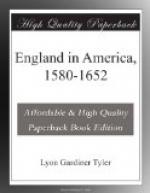The popularity of the measure, however, increased mightily, and there is a tradition that in the winter of 1634-1635 some persons from Watertown went to Connecticut and managed to survive the winter in a few huts erected at Pyquag, afterwards Wethersfield.[46] The next spring the Watertown and Dorchester people imitated the Newtown congregation in applying to the general court for permission to remove. They were more successful, and were given liberty to go to any place, even outside of Massachusetts, provided they continued under the Massachusetts authority.[47]
Then began a lively movement, and Jonathan Brewster, in a letter written from the Plymouth fort at Windsor in July, 1635, tells of the daily arrival by land and water of small parties of these adventurous settlers. Their presence around the fort caused Brewster much uneasiness, since some began to cast covetous eyes upon the very spot which the Plymouth government had bought from the Mohegans and held against the Dutch.
As their numbers grew their confidence increased; and finally the men of Dorchester, headed by Roger Ludlow, one of the richest men in Massachusetts, pretending that the land was theirs as the “Lord’s waste,” upon which “the providence of God” had cast them, intruded themselves into the actual midst of the Plymouth people. The emigrants from Plymouth protested, but were finally glad to accept a compromise, though, as Bradford remarks, “the unkindness was not soon forgotten.” The Massachusetts settlers held on to fifteen-sixteenths of the land, while they magnanimously conceded to the Plymouth people one-sixteenth, in addition to their block-houses.[48]
The emigration in the summer of 1635 was preliminary to a much larger exodus in the fall. In October a company of about sixty men, women, and children, driving before them their cows, horses, and swine, set out by land and reached the Connecticut “after a tedious and difficult journey";[49] but the winter set in very early, and the vessels which were to bring their provisions by water not appearing, they were forced to leave their settlement for fear of famine. They were fortunate to find a ship frozen up in the river, which they freed from the ice and used to return to Boston. The other settlers who remained upon the river suffered very much, and were finally reduced to the necessity of eating acorns and ground-nuts, which they dug out of the snow. A great number of the cattle perished, and the Dorchester Company “lost near L2000 worth."[50]
These calamities were soon forgotten; and as soon as the first flowers of spring suggested the end of the dreary winter season, the Newtown people prepared to move. Selling their lands on the Charles River to the congregation of Rev. Thomas Shepard, the whole body, in June, 1636, emigrated through the green woods, musical with birds and bright with flowers, under the leadership of their two eminent ministers, Thomas Hooker and Samuel Stone.[51] Among the lay members of the community were Stephen Hart, Thomas Bull, and Richard Lord.[52] A little later the churches of Dorchester and Watertown completed their removal, while a settlement was made by emigrants from Roxbury under William Pynchon at Agawam, afterwards Springfield, just north of the boundary between Massachusetts and Connecticut.[53]




